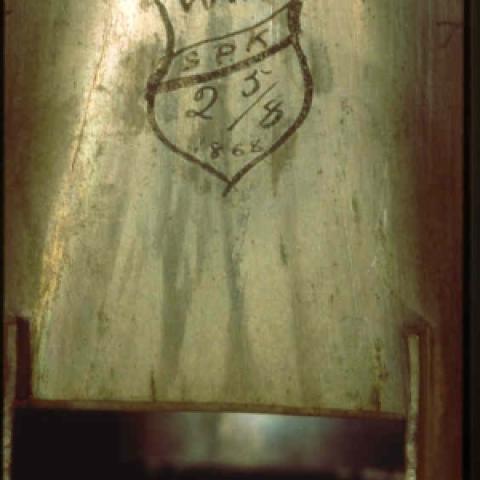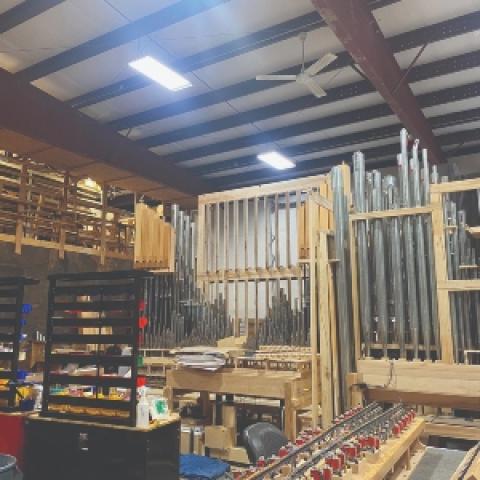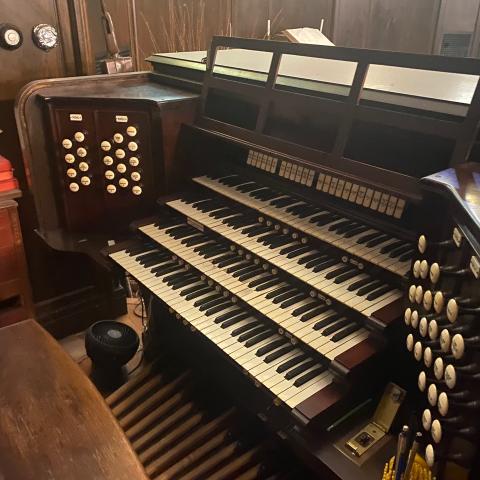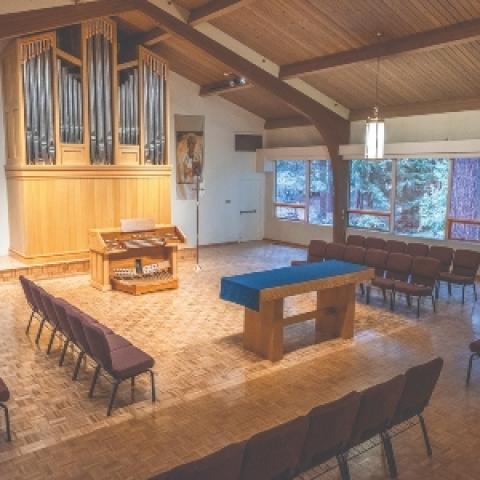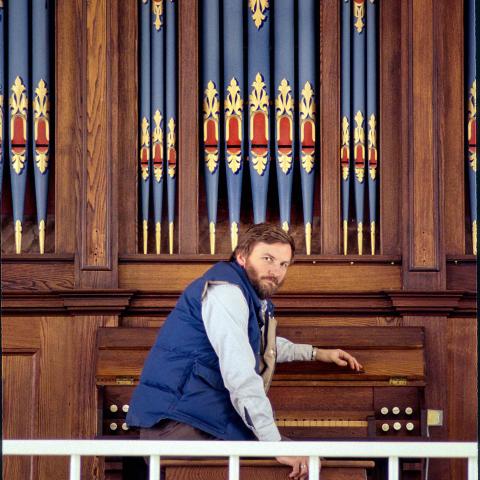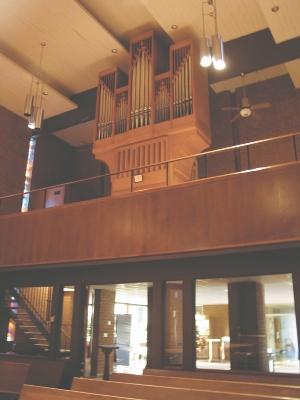
Why sell an organ?
Boston has long been a center for pipe organ building starting before 1810 with William Goodrich and Thomas Appleton and continuing with E. & G. G. Hook (later E. & G. G. Hook & Hastings, and later still Hook & Hastings), George Stevens, George Hutchings, Ernest Skinner, Aeolian-Skinner, Andover, Fisk, Noack, and many others. I have calculated that in over two hundred years, Boston organ builders collectively produced around 9,000 instruments. Compare that to the single firm of M. P. Möller, Inc., which built roughly 13,500 organs in around 120 years. Many of those were simple stock models like the ubiquitous Artiste, which in some years were pushed out the door at the rate of more than one a day.
Starting in the early 1960s, several new companies were formed to help usher in the “tracker revival,” most notably Fisk and Noack. Among those lesser known today was Robert Roche, whose workshop was in Taunton, Massachusetts. Bob was of Portuguese heritage, well informed, and a very fast talker—it was hard to get a word in edgewise. Along with his activities building, rebuilding, and restoring organs, he ran a small-scale organ supply company, providing parts, tools, and supplies for pipe organ builders. In the late 1980s when I was starting the Bishop Organ Company, I drove to Taunton to pick up a load of something or other, and during the expected yak-fest, Bob gave me his best advice for a nascent independent organbuilder, “Never build an organ for a wealthy church. You’ll create your magnum opus, and they’ll swap it out in twenty years.” I remember thinking if I ever had a chance to build an instrument for a wealthy church, I would go ahead and take my chances, and as far as I know, Bob never had that opportunity.
Church of the Redeemer (Episcopal) in Chestnut Hill, Massachusetts, my mother’s home parish, is nestled in an affluent neighborhood a couple miles west of Boston. The original organ by Kimball, Smallman, & Frazee was installed in 1915 when the building was completed. Möller Opus 9475 was installed there in 1961, followed by Noack Opus 111 in 1989. Schoenstein Opus 172 replaced the Noack in 2018, the third organ I have known personally in the same church, and the third organ there in less than thirty years. My first organ teacher, Alastair Cassels-Brown, was organist at Redeemer in the 1980s, and I maintained the Möller for him. My college pal Gregg Romatowski was organist there when the Noack was acquired. Sadly, Gregg died of AIDS shortly thereafter.
My dear friend Michael Murray, who shared organist duties at my wedding to Wendy with his husband Stuart Forster, had a productive tenure at Redeemer during which the Schoenstein organ was commissioned, twelve years after Schoenstein Opus 149 was installed at Christ Church, Cambridge, Massachusetts, where Stuart was organist. The Organ Clearing House removed the Noack and returned it to the Noack shop in Georgetown, Massachusetts, where it was renovated and enhanced for Saint Paul’s Chapel on lower Broadway in New York City, part of the fabled congregation of Trinity Church, Wall Street. We installed the organ at Saint Paul’s, and later helped install the Schoenstein at Redeemer.
Our wedding was at Saint Andrew’s Episcopal Church in Newcastle, Maine, home of Hutchings Opus 182 (1888) and the first church building designed by the brilliant ecclesiastical architect Henry Vaughan. Vaughan wanted the ceiling painted with frescoes, but funds were not available, so he did it himself, lying on his back on scaffolding. (Henry Vaughan also designed Church of the Redeemer in Chestnut Hill.) Stephen White, a former student of my father who taught homiletics at the Episcopal Divinity School in Cambridge, Massachusetts, was rector of Saint Andrew’s at the time of our wedding. He and dad celebrated the wedding together. Stephen was the former rector at Church of the Redeemer in Chestnut Hill.
Did you get all of that? It is hard to imagine that I could have so many connections with one church except to add that I accompanied a local choral society in a performance of Gabriel Fauré’s Requiem in D Minor on the Noack organ at Redeemer a few days after September 11, 2001.
Of course, there have been hundreds of other churches in my life. Even as adults, my kids still joke that when driving, I navigate by steeples.
What were they thinking?
From my seat in the Organ Clearing House, the concept of changing organs is always on my mind. Several times a week, I hear from a church wishing to buy or sell an instrument, and I am usually corresponding about ten organs at any given time. It has been especially intense in the last few weeks as we placed an instrument built by Mander Organ Builders in 1991 for Christ Episcopal Church, Pittsford, New York, on the market. It has two manuals and twenty-five stops and an especially beautiful case with brilliant proportions, rich carvings, and polished tin façade pipes with gilded mouths. The organ glows in the dark.
When I published the organ’s availability on our website and posted a link on Facebook, several serious potential purchasers responded quickly, as did the all-knowing community of organ watchers who lurk there. “What church would sell an organ like that?” “A praise band must be next.”
The Mander organ replaced a Wicks built in 1947 that had been “improved” several times by technicians whose intent exceeded their abilities. The new organ, standing prominently on the church’s long axis, brought brilliance and clarity of tone to the room for the first time. The Mander was fifteen years old when the rector encouraged the enhancement of the music program. The music director’s position was expanded to full-time with a mandate to expand the choir program, bringing a new level of excellence and depth to the music of worship. The growing choir, which had been seated in the rear of the church with the Mander, returned to seats in the chancel. Organist David Baskeyfield brought in a Hauptwerk instrument to accompany the choir and lead music from the chancel, and an organ committee is working on plans for the acquisition of a new pipe organ to be placed around and behind the chancel, especially designed for sophisticated choral accompaniment.
All this reflects the church’s thoughtful and constructive commitment to excellence in music, not irresponsibility for the Mander organ. As I write this, I am corresponding with several potential purchasers where the organ would be placed in superior acoustics and appreciated for its many strengths. It is a thrill to watch a church’s music program grow quickly enough to outgrow a brilliant thirty-year-old organ. I commend the church for bringing two fine organs into existence, and I am grateful for the lively chat online about this superb instrument.
Better get it out of there. . . .
In 2002, I was asked to sell an organ built by Hellmuth Wolff in 1976 with two manuals and seventeen stops. Hellmuth was upset that the church was rejecting his organ and asked me to convince them to keep it, but the church’s new organist was eager to have a large four-manual digital instrument and had no interest in retaining the Wolff organ. When I learned that the organist’s domestic partner was the senior warden of the church, I was pretty sure we were not going to stop it, and when that organist suggested that some of the pipes from the Wolff might be retained to enhance the digital instrument, I told Hellmuth that we had better get that organ out of there before something bad happened to it.
The organ was purchased by Saint Paul’s Lutheran Church in Durham, North Carolina, which already owned a one-manual organ by John Brombaugh. In 2003 we moved the Brombaugh to the front of the church and installed the Wolff organ in the balcony. The church brought Hellmuth to Durham for the dedication of the organ, a happy moment for him after so much frustration and disappointment.
Hellmuth Wolff was born in 1937 in Switzerland, apprenticed with Metzler, and then worked for Rieger and Fisk. He moved to Canada in 1963 to work as a designer in the new mechanical-action department at Casavant alongside Karl Wilhelm. In 1964, he and Karl installed a forty-six-rank Casavant, Opus 2791, at Saint Andrew’s Episcopal Church in Wellesley, Massachusetts. The Organ Clearing House subsequently sold that organ to Saint Theresa Catholic Church in South Hadley, Massachusetts. It was relocated by Messrs. Czeluzniak et Dugal in 2005. Juget-Sinclair Opus 4 with two manuals and forty-five ranks was installed at Saint Andrew’s in 2006. Organ Clearing House president Amory Atkins and his wife Virginia Childs were married at Saint Andrew’s in 1991. Hellmuth and Karl both established successful independent firms in Québec. Hellmuth passed away in 2013.
Miles and piles . . .
Nativity Catholic Church in Timonium, Maryland, was home to a twelve-rank Schlicker organ built in 1986. We sold the organ to All Saints’ Episcopal Church in Kapa’a, Hawaii, in 2015. The reason the organ was offered for sale was obvious the instant I entered the building, as predicted by one of the errant Mander commentators. There was an elaborate rock-and-roll setup adjacent to the organ console, with miles and piles of wire coiled and snaking about, woven between microphone stands, mixers, drums, and stools. We found handfuls of guitar picks and used nine-volt batteries instead of the usual pencils under the pedalboard. We sent the organ to Rosales Organ Builders in Los Angeles. They renovated and expanded the organ and installed it at All Saints’ in 2020. Adam Pajan played the dedicatory recitals. Shane Morris Wise is the organist at All Saints’.
If the shoe fits . . .
Saint Mark’s Episcopal Church in Glendale, California, was home to a forty-four-rank Schlicker organ with three manuals built in 1963. In 2008, the organ was ready for renovation, and the people of Saint Mark’s chose to offer it for sale so they could acquire a more “Anglican” instrument. First Lutheran Church of Montclair, New Jersey, purchased the organ in 2010. It was renovated and relocated by the Organ Clearing House, and installation was completed in 2015. Pastor Will Moser of First Lutheran Church, now retired, is also an organist. He had grown up in the thrall of Schlicker organs, considering them to be the quintessential Lutheran instrument.
Saint Mark’s Church in Glendale acquired Skinner Organ Company Opus 774, built in 1930 with three manuals and thirty ranks. It was restored and installed by Foley-Baker, Inc., in 2009. With two expressive divisions, three pairs of celestes, and three colorful orchestral reeds, that organ is ideally suited for the Anglican liturgy and the accompaniment of Anglican choral music and chants. Two radically different organs were exchanged to provide their congregations with instruments especially well suited for their individual musical traditions.
§
I have written about organs being sold because styles and opinions change, or because an active church outgrows an instrument, but of course the most common reason for the sale of pipe organs is the closing or merging of churches. When a congregation dwindles and its resources are stretched too thin for feasible operation and starts planning for the sale of their building, they should also begin planning for the future of their organ. Conversely, real estate developers often contact me about selling an organ in a building they have purchased when there is a month or less before they start demolition.
When selling a pipe organ, a year is like a lightning strike. When a church is considering acquiring an organ, there is typically a long committee process. A group travels to audition an available organ and organbuilders inspect it and provide proposals for renovation and relocation, which are presented to the congregation. Organ committees, music committees, finance committees, and parish councils or vestries discuss the proposals. Sometimes fundraising does not start until that entire process is complete. The organ that was offered for sale a month before demolition has long been reduced to rubble.
A church that is considering closing should start working on the sale of an organ as soon as feasible. It may be a bitter pill to swallow, but it is better than watching an organ go down. When there is time to work with, an organ can command a higher price—its cash value plummets as time runs out. This also applies to the church that has commissioned a new instrument and faces a deadline for the removal of an organ. The worst case in that situation is for a church to have to pay to scrap an organ that has run out time. If your church has decided to replace its organ, get the old one on the market right away, even before the new contract is signed.
Another option to remember when selling a church building is the possibility of retaining ownership of an organ in a sales agreement. If the building sells before the organ, the buyer might agree to allow for the removal of the organ six months, a year, or more after the building changes hands. We once removed a large organ from a church building that had been sold over a year earlier. The original congregation still owned the organ, and the new one was contractually obligated to allow for its removal, but they were not pleased with the impending disruption, and there were some contentious issues to work out. When we offered the use of our scaffolding for the installation of planned new lighting, all the squabbling ended.
The cash value of a vintage pipe organ is determined largely by circumstances and by the market. Any church considering the acquisition of a vintage instrument will be facing significant expense for renovating and relocating the instrument. When a seller insists that the asking price should be comparable to new, I simply remind them that the cost of a new organ includes transportation and installation and assumes that the organ is in mint condition. You have to subtract the cost of relocation, installation, and any necessary renovation to determine a reasonable asking price.
There is a finite amount of money spent on pipe organ projects in the United States every year, and I have adopted the attitude that I need to do all I can to be sure that those precious resources are spent on wonderful instruments. If a church owns a simple organ in poor condition and wants to keep using it, I am ready to encourage them to spend money on repairs, but if there is no hope of a project resulting in a credibly useful organ, I do not see the point. There is such a thing as an organ without any artistic merit. I try to encourage churches looking to purchase an organ to consider those of highest quality first. I am not comfortable advocating a mediocre organ when excellent instruments are available at similar cost. That guides my decisions regarding accepting new listings. There are always many times more organs available than we will ever be able to place, so let us concentrate on the best.
It is immensely satisfying to place a fine organ in a new home once its time has run out somewhere else. New organs are typically planned carefully for the spaces they will inhabit, but it is remarkable how often an instrument adapts beautifully to a new home with minimal changes. We’ll never be able to save them all, but it’s fun to try.

